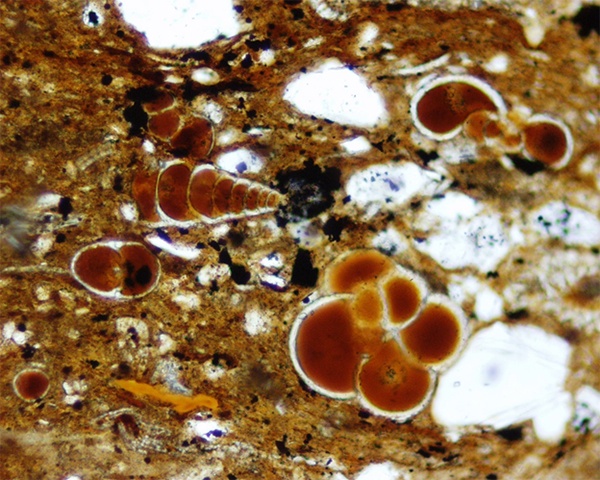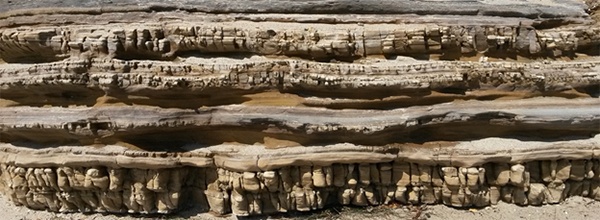Monterey Formation of California
The Miocene Monterey Formation is a thick, remarkably organic-rich marine deposit that extends vast distances across and offshore of California. It is composed chiefly of the remains of microscopic plankton – diatoms, coccolithophorids and foraminifera – that undergo dramatic changes with burial after deposition on the seafloor that transform the properties of the rocks.

The Monterey is of great regional and international significance because it is the primary source of oil in California and also accumulated so much carbon, silica and phosphate in its deposits that it likely perturbed global biogeochemical cycles and transformed the world's climate and ocean chemistry. Due to its fantastic outcrops and abundant subsurface data, it also serves as an important analog for other deep-marine deposits around the world.

Our group takes a holistic, Earth Systems approach and investigates the interconnections between paleoenvironmental conditions at deposition, sediment composition, diagenesis (changes with burial), and rock properties (including porosity, hardness and deformational style). We also research how these dramatic changes influence the fidelity of the sedimentary record of past environmental change.

Relevant Papers
- Wirtz, Y., and Behl, R.J., 2021. Compositional and Diagenetic Control of Bed- to Formational-Scale Deformation in Siliceous Sedimentary Rocks, Santa Maria Basin, California, Geological Society of America special publication.Behl, R.J., 2011, Chert spheroids of the Monterey Formation, California (USA): early diagenetic structures of bedded siliceous deposits, Sedimentology. v. 58, p. 325–351. doi: 10.1111/j.1365-3091.2010.01165.x
- Hancock, L.G., Hardisty, D.S., Behl, R.J., Lyons, T.W., 2019. A multi-basin redox reconstruction for the Miocene Monterey Formation, California, USA, Palaeogeography Palaeoclimatology Palaeoecology, January 2019. doi: 10.1016/j.palaeo.2019.01.031
- Hill PS, Behl RJ. 2019. Milankovitch stratigraphy in the Miocene–Pliocene Monterey marine succession offshore central California. In Marsaglia KM, Schwalbach JR, Behl RJ (Editors). From the Mountains to the Abyss: The California Borderland as an Archive of Southern California Geologic Evolution, Special Publication 110: SEPM (Society for Sedimentary Geology). doi: 10.2110/sepmsp.110.16
- Behl, R.; Gross, M., 2018. Stratigraphy, Diagenesis, and Structural Deformation of the Monterey Formation, Central California Coast, SEPM Field Trip Guidebook 14, 119 p. Print ISBN 978-1-56576-358-6, eISBN 978-1-56576-359-3.
- Föllmi, K.B., Thomet, P., Lévy, S., De Kaenel, E., Spangenberg, J.E. Adatte, T., Behl, R.J., Garrison, R.E., 2017. The Impact of Hydrodynamics, Authigenesis, and Basin Morphology On Sediment Accumulation In An Upwelling Environment: The Miocene Monterey Formation At Shell Beach and Mussel Rock (Pismo and Santa Maria Basins, Central California, U.S.A.), Journal of Sedimentary Research, 87 (9) 986-1018; doi: 10.2110/jsr.2017.57
Masters Theses
- Farrell, John, 2020. Lateral Facies Variation of Fine-Grained, Organic-Rich Sediments of the Miocene Monterey Formation, Belridge Field Area.
- Giannetta, Leo G., 2019. Chemostratigraphic and Lithostratigraphic Framework of the Eocene Kreyenhagen Formation: Kettleman Area, Northern San Joqauin Basin, California.
- Sedlak, Alex, 2020. Geochemistry of the Monterey Formation in the San Joaquin Basin, California.
- Mortimer-Lamb, Megan R., 2019. Quantification of the Biosiliceous Miocene Lark Formation, Danish North Sea and Norwegian Margin.
- Davis, Maia C.; 2018. Spatial and Geochemical Characterization of an Anomalous, Map-Scale Dolomite Breccia in the Monterey Formation, Santa Maria Basin, California.
- Weller, Ryan M., 2018. Compositional and Diagenetic Controls of Hardness in Siliceous Mudstones of the Monterey Formation, Belridge Oil Field, CA: Implications for Fracture Development.
- Wirtz, Yannick; 2017. Strain Variation between the Monterey and Sisquoc Formations, Southern Santa Maria Basin, California, USA: Implications for Structural Assessment of Fold and Thrust Belts.
- Kassa, Tesfalidet G., 2016. Pore structure of opal-CT and quartz porcelanites, Monterey Formation, California.
- Njuguna, Wanjiru M., 2016. Mixed silicilcastic-siliceous succession, Miocene Monterey formation, Point Dume to Paradise Cove, Malibu, California.
- Ijeoma, Idu Opral C.; 2014. A test of diagenetic ordering in siliceous lithofacies, Monterey Formation, southwestern Casmalia Hills, Santa Maria Basin, California.
- Torn, Daniel; 2014. Sedimentology and stratigraphy of diatomaceous sediments in the Casmalia Hills and Orcutt oil fields in the Santa Maria basin, California.
- Lanners, Rebecca K.; 2013. Chemostratigraphy of hemipelagic facies of the Montery Formation and equivalent sedimentary rocks, Los Angeles basin, California.
- Strickland, Heather M.; 2013. Fracture networks and mechanical stratigraphy in the Monterey-equivalent Pismo Formation and its relationship to primary sedimentology and stratigraphy at Montana de Oro State Park, California.
- AlShammary, Nawaf S.; 2013. Hetergenerous oil saturation in submarine channel and adjacent facies, Monterey Formation, Point Fermin, Palos Verdes, California.
- Mosher, Annie.; 2013. Detailed lithostratigraphic characterization of The Monterey Formation at Chico Martinez Creek, California.
- Hill, Pamela S.; 2005. Use of Milankovitch cyclicity as a high-resolution dating and correlation tool in the Upper Neogene sediments of the Monterey and Sisquoc formations of the Santa Maria Basin of the central California margin.
Acknowledgements
The Corporate Affiliate donors of the CSULB MARS Project: Monterey and Related Sediments.





